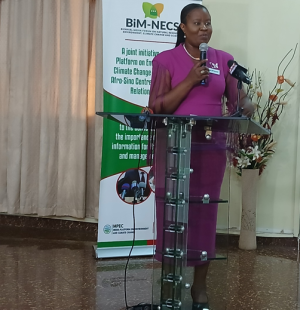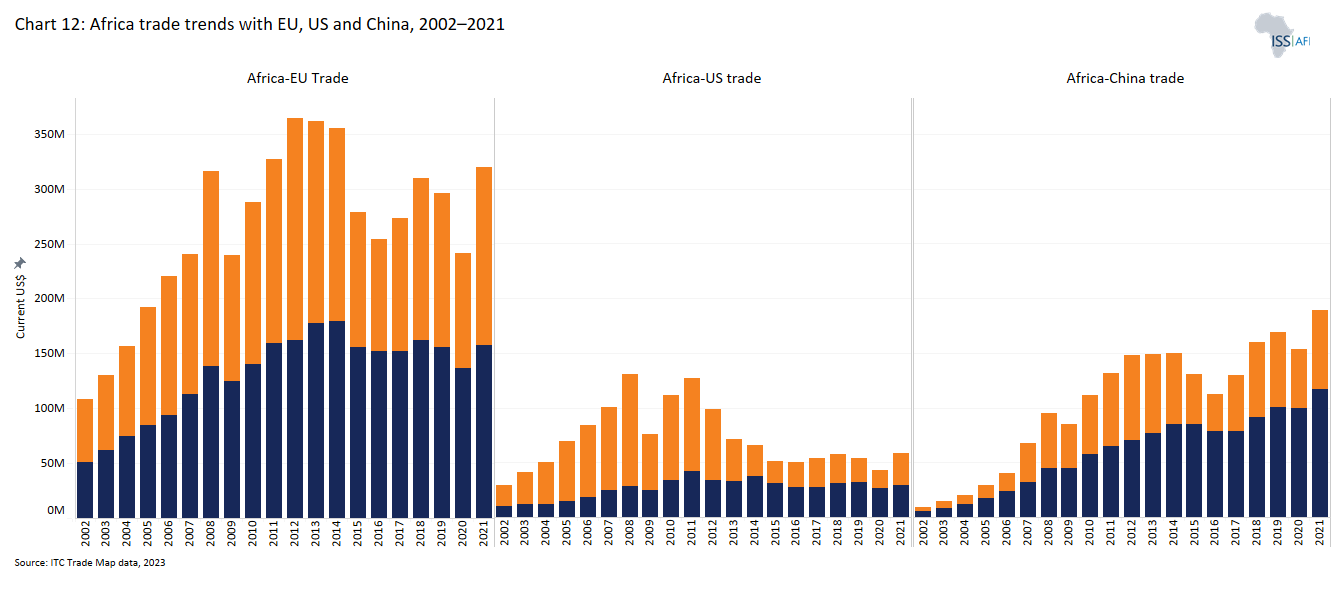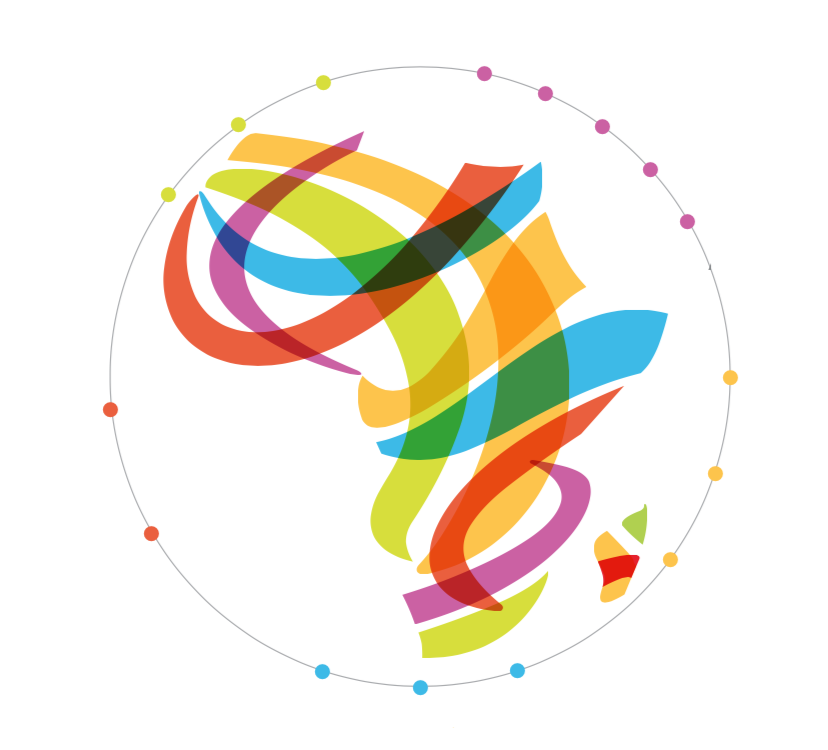
By Ama Kudom-Agyemang
As Ghana's forests, wetlands, and grasslands face increasing strain from human activities and climate change, the 2nd Biennial Media Forum on Natural Resources, Environment, Climate Change and Science (BiM-NECS 2) emerged as a strong appeal for coordinated efforts.
Focusing on the theme "Ecosystem Restoration: The Politics, the Science, the Human, and the Economy," the Forum brought together journalists, government representatives, scientists, researchers, development professionals, civil society members, and gender advocates in Kumasi on Tuesday, 3rdJune 2025, to envision the future of environmental restoration, considering both policy and community perspectives.
Advancing Ghana's inherent stake in restoring ecological systems
During her keynote speech, Professor Mercy Adutwumwaa Derkyi, the Director of the Quality Assurance and Academic Planning Directorate at the University of Energy and Natural Resources (UENR) in Sunyani, recognized Ghana's strong commitment to restoring ecosystems, as demonstrated through significant efforts like the Bonn Challenge, the National Reforestation Program, Green Ghana, and Tree for Life, which engage both governmental and non-governmental entities.
Nevertheless, she emphasized that the effectiveness and long-term viability of these initiatives are challenged by "the dynamics of power, societal problems, failures in governance, corruption, and insufficient enforcement."
Professor Derkyi emphasized the need for robust political commitment and authentic participation from the grassroots level, which are essential in addressing these structural issues. "We must ask ourselves," she stated, "how can we transition from verbal promises to real actions? Who determines which ecosystems are most important? And how can we effectively enable local communities in this process?"
When addressing these questions, the main speaker presented various key principles for successful ecosystem restoration, such as: defining clear restoration objectives, evaluating the ecosystem's ability to recover, deciding between natural regrowth and supported restoration methods, prioritizing conservation in regions considered irreparable, and integrating scientific understanding with traditional ecological knowledge (TEK).
Professor Derkyi highlighted the significance of utilizing advancements in ecological science, including remote sensing, drone technology, geographic information systems (GIS), and new AI tools, to track ecosystem health and support data-driven solutions. She stressed that "combining scientific knowledge with traditional ecological knowledge (TEK) is essential for developing sustainable and equitable restoration approaches."
Among the scientific and institutional efforts she emphasized were: the Council for Scientific and Industrial Research-Forestry Research Institute of Ghana’s (CSIR-FORIG) initiatives in producing high-quality forest tree seedlings and promoting less commonly used species; and UENR’s Earth Observation Research and Innovation Centre (EORIC), which offers real-time satellite and GIS solutions across areas like climate, disasters, biodiversity, water, energy, agriculture, ecosystems, and health. This encompasses the Carbon Tower Project as part of the Carbon Flux Monitoring Project in Bia Tano, which monitors carbon dioxide levels at the forest level and aids Ghana's efforts in mitigation and adaptation.
Professor Derkyi mentioned another important project, the "EU-funded Landscapes and Environmental Agility across the Nation (LEAN)" initiative, which she praised for integrating scientific study with indigenous knowledge. Managed by Tropenbos Ghana and EcoCare Ghana along with their local collaborators, the LEAN project promotes community participation and offers research funding to university students, including those from UENR.
Professor Derkyi also urged the creation of a national Data Center to monitor advancements in Ghana's ecological restoration goals, particularly those within the UN Decade of Ecosystem Restoration, and to promote openness and responsibility. She supported the active participation of important organizations such as the Forestry Commission, academic institutions, and the media to ensure broad partnerships that improve communication and cooperation between researchers and journalists.
"Restoration goes beyond nature—it also involves people's means of living," said Prof. Derkyi, adding that "Vibrant ecosystems can promote green employment, eco-tourism, and sustainable local businesses." Nonetheless, she warned that restoration should not depend only on outside financial support, which tends to be temporary. She suggested a sustained national dedication and funding for nature-focused initiatives.
The human aspect of restoration
The Principal Project Manager at Proforest's African Regional Office in Accra, Afua Serwaa Akoto Prempeh, who led the event, called on the media to transform data on environmental decline and climate change into narratives that reflect the daily experiences of Ghanaians.
To reinforce her argument, she cited the case of 17-year-old Aisha from Kundugu, located in the Wa East District of Ghana's Upper West Region. Having moved south, she currently works as a porter in the Madina market. Ms. Prempeh highlighted the financial impact of climate change on rural communities, cautioning that without immediate climate measures, an extra million individuals might slip into poverty, with family incomes expected to decrease by up to 40% by 2050.
"These are more than just figures," she emphasized. "They represent the real-life experiences of many young people like Aisha, whose families can no longer sustain themselves through farming because of climate changes." Ms. Prempeh referenced Aisha's story to highlight some key issues.
First, it supports research conducted by the International Water Management Institute (IWMI) demonstrating that in northern Ghana, a region highly vulnerable to climate change, youth migration (both from rural to urban areas and rural to rural areas) is a common occurrence, with almost one out of every five young people from the north living in the south. Secondly, Aisha’s story transforms politics, facts, statistics, scientific data, and abstract concepts into real-life experiences, "highlighting the intersectionality between people, nature, and climate."
The Chairperson mentioned that Ghana requires approximately $2 billion each year to properly address the effects of climate change. She highlighted that this significant amount emphasizes the essential role of the media in presenting climate information in a way that is easier for the public and decision-makers to understand and use.
Mrs. Prempeh commended the Forum's original mission, which acknowledges thathowthe way the media conveys environmental matters is equally important aswhatis conveyed. "The media plays a significant role in spreading information of public concern, such as topics concerning natural resources, the environment, climate change, and science, through understandable and practical knowledge materials."
She further emphasized the significance of diversity, encouraging the media to make sure that underrepresented perspectives are included in the discussion.
EPA’s new environmental face
The Environmental Protection Authority (EPA) regional director for Ashanti, Dr. Jackson Nyantakyi, shared key points of the recently passed Environmental Protection Act, 2025 (Act 1124). This new legislation supersedes the old Environmental Protection Act 1994 (Act 490), which created the Environmental Protection Agency. Act 1124 tackles shortcomings like insufficient penalties, ineffective coordination between agencies regarding environmental issues, and limited focus on climate change matters.
Significantly, Act 1124 grants the Authority the ability to prevent rezoning when there are environmental dangers and creates a National Environment Fund to support ongoing sustainability projects.
Future Perspectives: The Media's Critical Function
Launched in 2023 by the Media Platform on Environment and Climate Change (MPEC) in collaboration with the Afro-Sino Centre of International Relations (ASCIR) and The Steminist Foundation Ghana, BiM-NECS remains committed to highlighting the role of media in environmental governance.
Highlighting the significance of the BiM NECS Forum, the Chairperson remarked: “This gathering takes place because we are convinced that thoughtful discussions can inspire transformation when they bridge understanding, application, and regulation in impactful manners.”
This year's Forum, held with assistance from Proforest and Tropenbos Ghana, concluded with the release of the BiM NECS 2 Kumasi Declaration. It presented 12 key actions, including a commitment to make ecosystem restoration a national and regional media focus through an annual media campaign in line with the UN Decade on Ecosystem Restoration.
As Ghana prepares to achieve its 2030 goals for ecosystem restoration, BiM-NECS 2 highlighted that restoring nature involves reestablishing links: between science and society, politics and communities, and economics and the environment.







 Zimbabwe has cautioned Chinese investors against ignoring local labor and environmental regulations, as well as engaging in illegal financial practices, a rare position following prolonged public grievances.
Zimbabwe has cautioned Chinese investors against ignoring local labor and environmental regulations, as well as engaging in illegal financial practices, a rare position following prolonged public grievances.
 Dar es Salaam. The East African Community (EAC) has taken over the rotating chairmanship of the COMESA-EAC-SADC Tripartite Task Force (TTF) at a crucial time, reigniting hopes for a more unified and integrated regional trade system. However, a central question remains: can this leadership role help the EAC overcome its internal challenges and lead to a genuinely tariff-free region? The TTF unites three major Regional Economic Communities (RECs): the Common Market for Eastern and Southern Africa (COMESA), the East African Community (EAC), and the Southern African Development Community (SADC). It was created to coordinate the implementation of the Tripartite Free Trade Area (TFTA). Launched in 2015, the TFTA aims to promote market integration, industrial growth, and infrastructure development across 29 African countries, serving a population of over 700 million. Yet, almost a decade later, progress has been slower than anticipated due to ongoing non-tariff barriers, delayed ratifications, and a lack of unified customs systems among member states. On July 25, 2024, the TFTA Agreement officially came into effect after securing the necessary 14 ratifications. However, the real challenge lies in putting the agreement into practice, a task now entrusted to the EAC as it assumes the TTF's leadership. EAC Secretary General, Ms Veronica Nduva, speaking at a high-level roundtable in Malabo, Equatorial Guinea, on July 14, 2025, advocated for a continent-wide resource mobilisation strategy to replace fragmented efforts that have hindered progress. "We must abandon disjointed approaches. Africa needs a harmonised strategy for resource mobilisation to effectively implement Agenda 2063," she stated. "We see the TFTA as a strategic tool to deepen integration, boost competitiveness, unlock intra-African trade, and advance inclusive industrialisation," she added. Ms Nduva also highlighted the importance of blended financing models involving public, private, and philanthropic capital, along with the use of technology to enhance coordination and accountability. The big question While the EAC’s assumption of leadership is diplomatically significant, the bloc has faced difficulties in implementing its integration protocols. Several EAC Partner States have previously failed to uphold agreed tariff removals, leading to internal trade disputes and delays in harmonisation efforts. Trade tensions between Kenya and Tanzania over products such as sugar, maize, and milk have revealed the inconsistent application of EAC trade rules, undermining the bloc’s credibility in broader integration efforts. According to Dr Paul Omollo, a regional trade policy analyst based in Dar es Salaam, the EAC must first address its shortcomings. "The EAC has made impressive commitments on paper. But implementation remains its biggest weakness," Dr Omollo told The Citizen by phone. "Taking over TTF leadership is significant, but the EAC must back that up with real reforms at home. It must demonstrate that regional integration can work, starting with its borders." What does chairing the TTF mean? Assuming the TTF chairmanship places the EAC in charge of guiding the finalisation of tariff offers, adoption of rules of origin, and encouraging ratification by the remaining states. The bloc is also expected to lead the revival of the TFTA’s industrial development pillar, one of its key components. "Our focus is to ensure that the TFTA becomes fully operational, not just in name but in action," said Ms Nduva. "We are pushing for the ratification of both the trade and movement of businesspeople agreements," she said. Experts believe this leadership position could allow the EAC to influence harmonised customs policies, coordinated infrastructure investments, and the development of joint industrial zones, provided there is strong political will among member states. "The TFTA could be a game-changer if it builds synergies across the three RECs," said a policy adviser at TradeMark Africa, Mr Humphrey Ramela. "The EAC’s leadership is timely. But success depends on aligning national interests with regional ambitions," he added. Another key theme from the Malabo roundtable was financial independence, with Ms Nduva reiterating the need for African nations to reduce reliance on external donors and adopt African-led financing models. "Austerity must go hand-in-hand with innovation. Resources allocated for development must be managed with discipline and efficiency," she noted. The African Union Commission Chairperson, Mahmoud Ali Youssouf, echoed this sentiment, urging member states to finance their development agendas and adopt the instruments required to operationalise the TFTA by the time of the next Tripartite Council of Ministers meeting. "African ownership is not optional; it is the only path to sustainable development," said Mr Youssouf. With preparations for the fourth Tripartite Summit underway, during which the TFTA will be formally launched, expectations are high. The EAC’s challenge will be to not only champion regional integration at the tripartite level but also prove its commitment to seamless trade within its borders.
Dar es Salaam. The East African Community (EAC) has taken over the rotating chairmanship of the COMESA-EAC-SADC Tripartite Task Force (TTF) at a crucial time, reigniting hopes for a more unified and integrated regional trade system. However, a central question remains: can this leadership role help the EAC overcome its internal challenges and lead to a genuinely tariff-free region? The TTF unites three major Regional Economic Communities (RECs): the Common Market for Eastern and Southern Africa (COMESA), the East African Community (EAC), and the Southern African Development Community (SADC). It was created to coordinate the implementation of the Tripartite Free Trade Area (TFTA). Launched in 2015, the TFTA aims to promote market integration, industrial growth, and infrastructure development across 29 African countries, serving a population of over 700 million. Yet, almost a decade later, progress has been slower than anticipated due to ongoing non-tariff barriers, delayed ratifications, and a lack of unified customs systems among member states. On July 25, 2024, the TFTA Agreement officially came into effect after securing the necessary 14 ratifications. However, the real challenge lies in putting the agreement into practice, a task now entrusted to the EAC as it assumes the TTF's leadership. EAC Secretary General, Ms Veronica Nduva, speaking at a high-level roundtable in Malabo, Equatorial Guinea, on July 14, 2025, advocated for a continent-wide resource mobilisation strategy to replace fragmented efforts that have hindered progress. "We must abandon disjointed approaches. Africa needs a harmonised strategy for resource mobilisation to effectively implement Agenda 2063," she stated. "We see the TFTA as a strategic tool to deepen integration, boost competitiveness, unlock intra-African trade, and advance inclusive industrialisation," she added. Ms Nduva also highlighted the importance of blended financing models involving public, private, and philanthropic capital, along with the use of technology to enhance coordination and accountability. The big question While the EAC’s assumption of leadership is diplomatically significant, the bloc has faced difficulties in implementing its integration protocols. Several EAC Partner States have previously failed to uphold agreed tariff removals, leading to internal trade disputes and delays in harmonisation efforts. Trade tensions between Kenya and Tanzania over products such as sugar, maize, and milk have revealed the inconsistent application of EAC trade rules, undermining the bloc’s credibility in broader integration efforts. According to Dr Paul Omollo, a regional trade policy analyst based in Dar es Salaam, the EAC must first address its shortcomings. "The EAC has made impressive commitments on paper. But implementation remains its biggest weakness," Dr Omollo told The Citizen by phone. "Taking over TTF leadership is significant, but the EAC must back that up with real reforms at home. It must demonstrate that regional integration can work, starting with its borders." What does chairing the TTF mean? Assuming the TTF chairmanship places the EAC in charge of guiding the finalisation of tariff offers, adoption of rules of origin, and encouraging ratification by the remaining states. The bloc is also expected to lead the revival of the TFTA’s industrial development pillar, one of its key components. "Our focus is to ensure that the TFTA becomes fully operational, not just in name but in action," said Ms Nduva. "We are pushing for the ratification of both the trade and movement of businesspeople agreements," she said. Experts believe this leadership position could allow the EAC to influence harmonised customs policies, coordinated infrastructure investments, and the development of joint industrial zones, provided there is strong political will among member states. "The TFTA could be a game-changer if it builds synergies across the three RECs," said a policy adviser at TradeMark Africa, Mr Humphrey Ramela. "The EAC’s leadership is timely. But success depends on aligning national interests with regional ambitions," he added. Another key theme from the Malabo roundtable was financial independence, with Ms Nduva reiterating the need for African nations to reduce reliance on external donors and adopt African-led financing models. "Austerity must go hand-in-hand with innovation. Resources allocated for development must be managed with discipline and efficiency," she noted. The African Union Commission Chairperson, Mahmoud Ali Youssouf, echoed this sentiment, urging member states to finance their development agendas and adopt the instruments required to operationalise the TFTA by the time of the next Tripartite Council of Ministers meeting. "African ownership is not optional; it is the only path to sustainable development," said Mr Youssouf. With preparations for the fourth Tripartite Summit underway, during which the TFTA will be formally launched, expectations are high. The EAC’s challenge will be to not only champion regional integration at the tripartite level but also prove its commitment to seamless trade within its borders.







